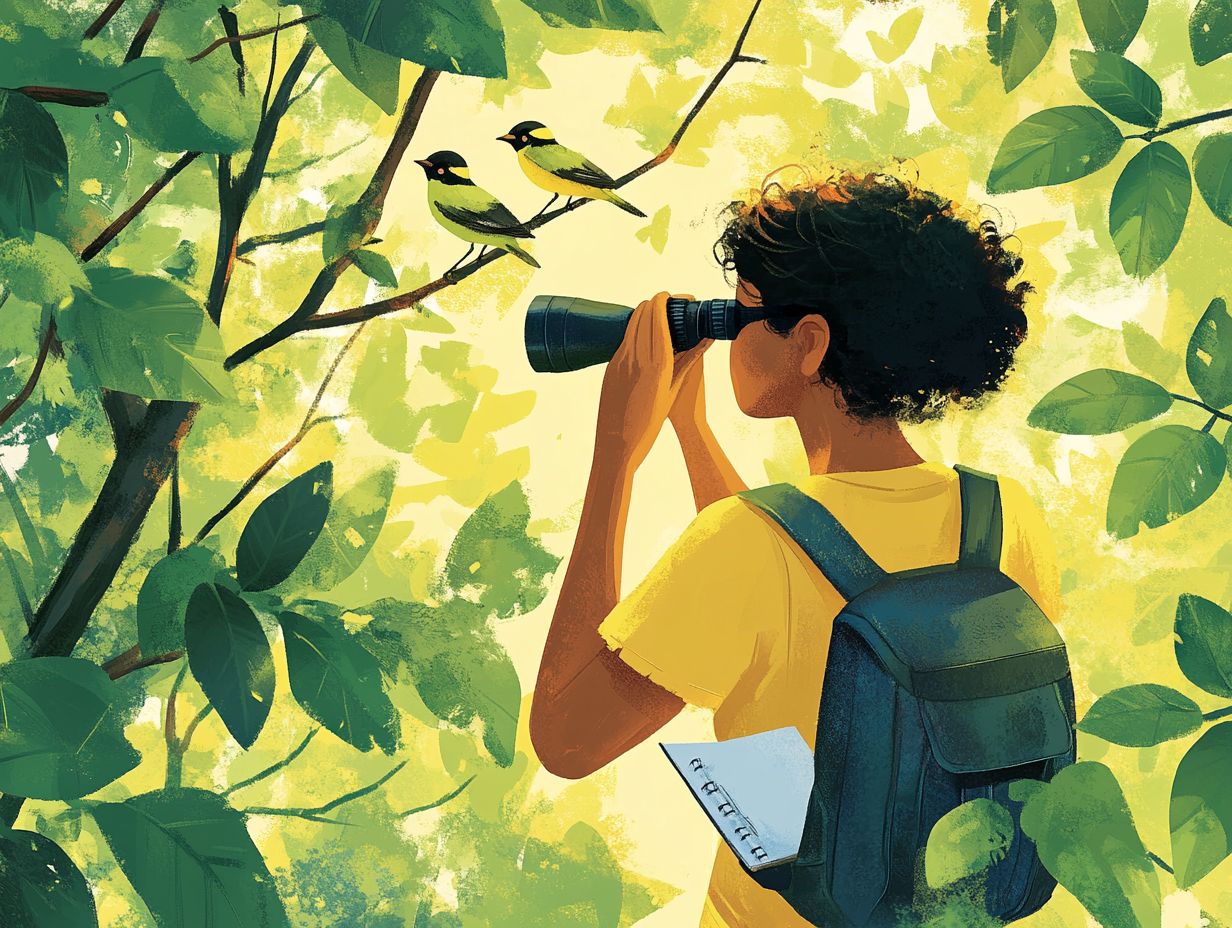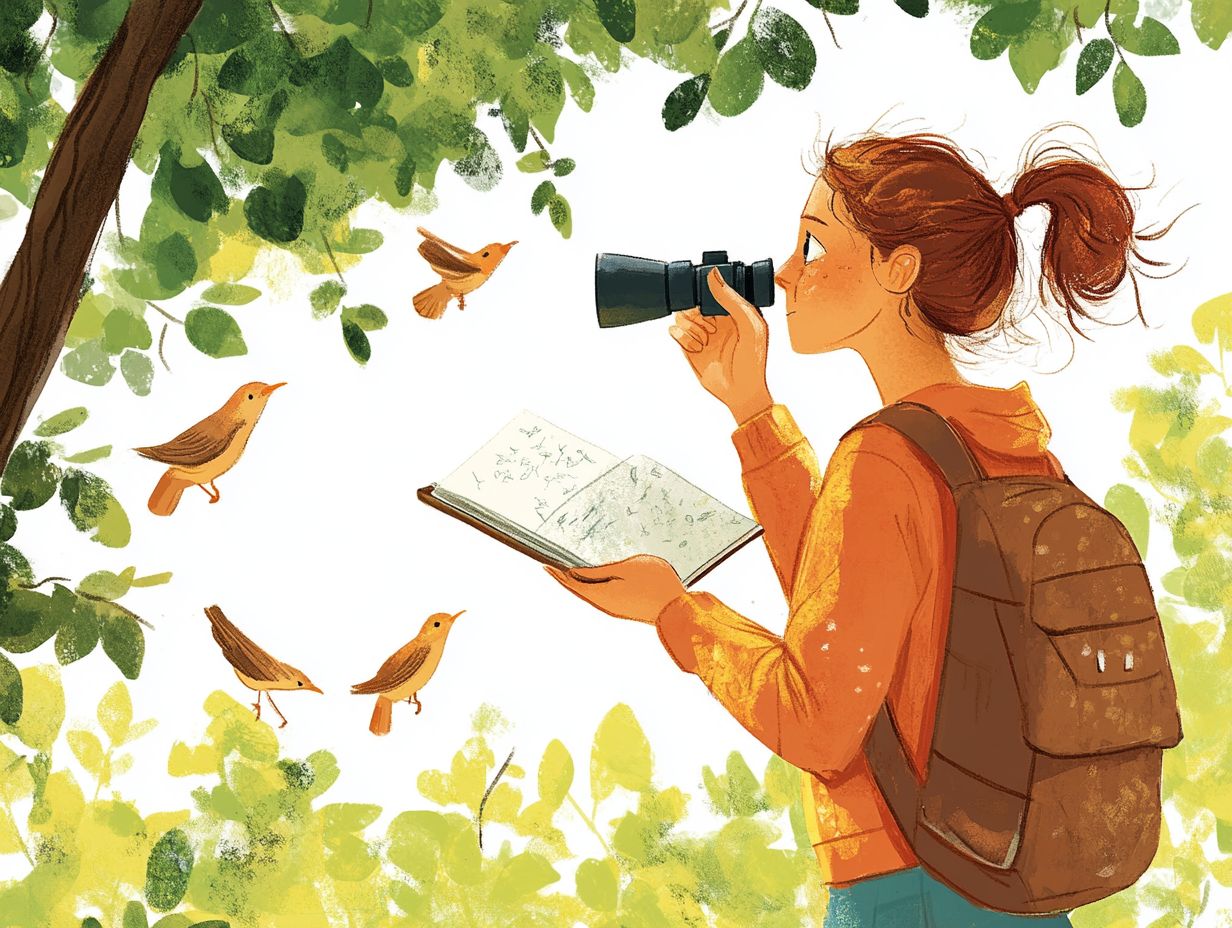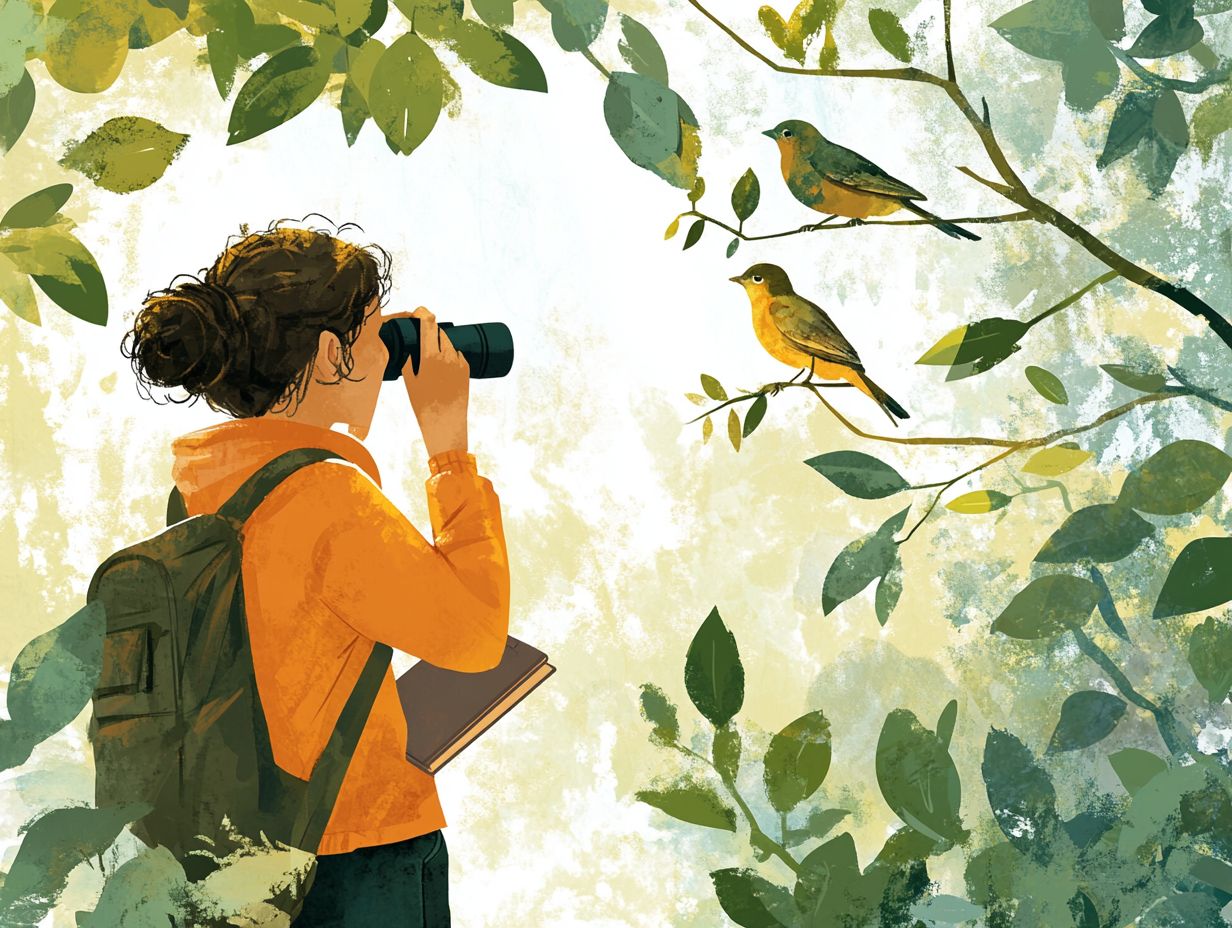Birdwatching is not merely a hobby; it is a captivating way to connect with nature and appreciate the beauty of wildlife.
Whether you are a curious beginner or seeking to refine your skills, this guide has you covered. You will learn about the history and essentials of birdwatching gear, as well as how to identify common species in the wild.
Additionally, we will explore the best locations, important etiquette, and tips for enhancing your birdwatching experience. Join us on this journey to uncover the wonders of avian life!
What is Birdwatching?

Birdwatching is an outdoor activity that involves observing and studying the behaviors of various bird populations in their natural habitats. This pastime has evolved from a simple hobby into a passionate pursuit for millions of people around the globe, enabling them to connect with nature while supporting wildlife conservation efforts.
Additionally, birdwatching has gained popularity as a form of citizen science, with enthusiasts documenting migratory birds and avian behaviors by keeping birdwatching journals or using specialized apps. As a hobby, birdwatching promotes relaxation and mindfulness, making it an accessible outdoor activity for individuals of all ages who wish to enjoy their local parks and nature trails.
Definition and History of the Hobby
The history of birdwatching as a hobby dates back to the 18th and 19th centuries, when naturalists began documenting their observations of birds, including the identification of species, their habitats, and behaviors. This documentation led to a greater appreciation for the diversity of birds during this period. Notable figures in ornithology, such as John James Audubon, John Gould, and Roger Tory Peterson, made significant contributions to the field. Peterson’s Field Guide to the Birds was one of the first field guides and quickly gained popularity among the public, helping to spark interest in birdwatching.
As more individuals became interested in bird identification, birdwatching clubs began to emerge in the late 19th century, fostering community and engagement among enthusiasts. These clubs proved to be invaluable resources for both novice and experienced birders, encouraging the sharing of field guides and observations, which enhanced the overall knowledge of the hobby.
By the 20th century, advancements in technology, such as the development of binoculars and the continued publication of field guides, transformed how birdwatching was approached. The increased availability of these tools made birdwatching a more accessible and enjoyable hobby for a broader audience.
Essential Gear for Birdwatching
Having the right birdwatching equipment is crucial for both novice and experienced birdwatchers, as it enhances the observation experience and aids in bird identification.
Binoculars are essential for viewing birds from a distance, and a quality field guide is invaluable for recognizing various species. Other important tools include:
- spotting scopes for long-distance viewing,
- birdwatching backpacks for carrying supplies,
- birdwatching apps that help record sightings and identify birds by their calls.
Each piece of equipment serves a unique purpose, ensuring that your birdwatching excursions are both enjoyable and successful.
Must-Have Items for Beginners

Essential items for beginner birdwatching include the following:
- Birdwatching Binoculars: Binoculars are often the most important piece of equipment for novice birdwatchers. The right pair allows for close-up views of birds, enhancing both identification accuracy and appreciation of their beauty. Choosing binoculars with the appropriate level of magnification and lens diameter is crucial for the best experience.
- Birdwatching Checklist: A birdwatching checklist is a simple yet effective tool for tracking the birds you observe. It helps improve your identification skills and allows you to record the time and location of each sighting. Checklists can vary in format, ranging from a simple piece of paper to more sophisticated smartphone apps.
- Birdwatching Field Guide: A beginner birdwatching field guide is a specially designed book that assists readers in identifying and learning about common birds in their area. Most field guides feature color illustrations or photographs of birds, along with information about their calls, habitats, and behaviors.
- Birdwatching Apps: Smartphone birdwatching apps are becoming increasingly popular and can be extremely helpful for tracking sightings and identifying birds, as well as learning their calls. Some apps serve as electronic replacements for traditional checklists, while others include field guides or offer features to help identify birds by answering a series of questions related to size, color, and other characteristics.
- Birdwatching Camera: A good camera tailored for birdwatching enables you to capture fleeting moments and study specific characteristics of birds in detail later.
- Birdwatching Clothing and Footwear: Comfortable and practical clothing, along with sturdy and supportive footwear suitable for the terrain you will explore, allows beginners to stay out longer and enjoy the experience more fully.
- Birdwatching Notebook: While not strictly necessary, a notebook for sketches, notes about your experiences, or reflections on your growth as a beginner birdwatcher can add significant meaning to your journey.
Identifying Birds in the Wild
Identifying birds in the wild is one of the most rewarding aspects of birdwatching, requiring careful observation and a solid understanding of various bird species. As a beginner, you can start by familiarizing yourself with the common birds in your area and practicing your identification skills through regular observation.
Techniques such as paying attention to bird calls, physical characteristics, and behaviors can assist you in recognizing different species. Utilizing resources like field guides and birdwatching apps, along with sharing experiences with members of birdwatching clubs, can greatly enhance your learning process and help you connect with the birdwatching community.
Common Species and How to Spot Them
Common Bird Species in Every Region of the World
Birdwatchers can expect to encounter a variety of common bird species in every region of the world. Understanding the characteristics of these birds and their preferred habitats is essential for successful birdwatching. For instance, checking local wildlife at specific birdwatching locations during particular times of the year can enhance the likelihood of spotting migratory species as they pass through. Recognizing the specific traits of common birds—including their plumage, size, and calls—can improve the chances of accurate identification and overall enjoyment of the birdwatching experience.
Characteristics of Common Bird Species
Birdwatchers should take note of the following characteristics of common bird species:
- Color:
- The vibrant red of a male Northern Cardinal in a suburban backyard in the eastern United States.
- The bright yellow of a male American Goldfinch in a flower garden during spring and summer.
- The subtle gray and brown of a Mourning Dove in a city park in the northeastern United States.
- Sounds:
- The cheerful whistling of a Carolina Wren with its “cheer, cheer, cheer” call in a southern garden.
- The lovely song of a Song Sparrow found in marshes or wetlands across many parts of North America.
- Size:
- The large, three-foot-long California Condor resting on a rocky ledge or cliff in California, Arizona, or Utah.
- The small, two-inch Anna’s Hummingbird flitting around flowers or feeders in California.
Behavioral Characteristics of Common Bird Species
Birdwatchers should also observe the following behavioral traits of common bird species:
- Feeding:
- Where and how birds feed can help locate them. For example, watch for the acrobatic pirouetting of Common Swifts as they feed on insect swarms in the summer and fall. Look for the probing bill of an American Robin as it hunts for invertebrates in open fields during spring and summer.
- Nesting:
- Birds often build nests in tree branches or shrubs. For instance, a Gray Catbird typically constructs a small cup nest in dense foliage within a garden or park, where it remains well concealed.
- Social Behavior:
- The tendency of birds to flock together varies, including whether they do so year-round or only during migration. For example, Blue Jay families stay together throughout the winter in trees or northern gardens, while American Black Ducks form flocks only in winter along marshes or bays.
- Habitat:
- The types of environments where birds are commonly found also vary. For instance, forests like the Oak Forest in the eastern United States provide excellent nesting areas for Black-capped Chickadees or Red-bellied Woodpeckers. Cities, suburbs, and farms serve as great feeding grounds for Rock Pigeons, House Sparrows, and Red-tailed Hawks. Each of these habitats requires different approaches by birdwatchers, as the time of year and specific environment will determine which types of birds are most likely to be seen.
Where to Go Birdwatching

The ideal locations for birdwatching are those that offer diverse habitats, as different regions around the world are home to various bird species.
Excellent places for birdwatching include:
- national parks
- nature reserves
- wetlands
These areas provide opportunities to observe a wide range of migratory birds, depending on the time of year.
Birdwatching tours can provide guided access to some of the best birdwatching sites, which are often rich in wildlife, as well as to lesser-known locations. These tours also offer opportunities to learn techniques from more experienced birders.
Best Locations and Seasons for Birdwatching
The best locations for birdwatching can vary from season to season, as different migratory birds are present at different times of the year. Coastal areas often serve as key birdwatching spots during the spring and fall, acting as important stopover sites during migration, while forests may be teeming with nesting birds in the summer.
Participating in local birdwatching events and festivals provides opportunities to explore these prime habitats and learn about the diverse flora and fauna that have adapted to them.
In the winter months, wetlands and reservoirs become prime locations, attracting many species such as ducks and geese that gather in larger numbers, making it easier to observe their fascinating behavior. Notable locations like the Everglades in Florida and the wetlands of San Francisco Bay offer an impressive variety of waterfowl during this season.
Birdwatching enthusiasts should also aim to visit during the peak of migration seasons, as birding festivals capitalize on these times by offering guided tours, expert presentations, and workshops that enrich the overall experience.
These events not only showcase the wonderful variety of birds but also raise awareness about the importance of protecting the habitats on which they depend.
Etiquette and Safety Tips
Adhering to proper etiquette and safety practices in birdwatching is essential for both the enjoyment of the hobby and the preservation of natural habitats. Birdwatchers should be mindful of their impact on wildlife and always maintain a safe distance from animals. It is also important to avoid getting too close to nesting sites or disrupting feeding locations.
Ethical birdwatching not only contributes to the conservation of certain species but also fosters a positive relationship between birders and the surrounding environment. By following principles such as observing birds quietly and minimizing noise pollution, birdwatchers can enhance their experience while allowing others to appreciate the natural sights and sounds around them.
Respecting Nature and Protecting Yourself

Respecting nature is essential for both wildlife welfare and your safety while birdwatching. By understanding the natural environment, including potential hazards such as rough terrain and unpredictable weather, you can better prepare for outdoor excursions. It is also crucial to know how to interact safely and responsibly with wildlife; for example, avoiding the use of bird feeding stations that disrupt naturally occurring foraging behaviors is vital for effective wildlife conservation. These considerations contribute to safe birdwatching while respecting nature, and the two goals often reinforce each other.
Your safety and the needs of the natural world are interconnected, and by following the guidelines below, you can ensure that both are met while enhancing your birdwatching experience:
- Be aware of the weather: Dress appropriately, including wearing sturdy footwear, to protect yourself from the elements and rough terrain. Carry essential supplies such as water, snacks, insect repellent, sunscreen, and a first aid kit.
- Stay vigilant: Always be aware of your surroundings, especially around nests, as many birds may become aggressive if they feel their nests are threatened. If birds appear agitated, use a telephoto lens or binoculars for a closer look rather than approaching them. If you’re uncertain about how close to get, consult the guidelines of the organization you are with or refer to the recommendations of the National Audubon Society if you are on your own.
- Minimize noise pollution: Avoid startling birds, as this can lead them to flee their habitats or abandon their nests. Even when not observing wildlife, take the opportunity to appreciate nature without the distractions of modern technology. Listening to the sounds of nature can enhance your experience and help you better understand the subtle ways birds communicate.
- Explore in small groups or alone: Large groups can overwhelm an area. If you prefer guidance, consider hiring a professional guide or inviting a few friends to accompany you. Guides are knowledgeable about their areas and can enrich your experience while alleviating safety concerns.
Birdwatching offers a remarkable opportunity to develop a deeper appreciation for the delicate balance between nature and humanity. The more you learn about avian life, the better you will be able to differentiate between the sounds of different species, identify their habitats, understand their behaviors, and recognize their unique characteristics.
Getting the Most Out of Your Birdwatching Experience
Birdwatching techniques and tips can enhance your experience, enabling you to locate rare birds and accurately document your observations. Patience and quiet observation are essential virtues that allow you to blend into nature, making birds feel safe and encouraging them to come closer.
Photography can also be a rewarding way to engage with birds while enriching your birdwatching journal and creating lasting memories. Additionally, practicing mindfulness in nature fosters a deeper connection with your surroundings, elevating your overall birdwatching experience.
Tips for Spotting Rare Birds and Documenting Your Observations
Here are some tips for spotting rare birds:
- Birdwatching Apps: Utilizing free or paid birdwatching apps can greatly enhance your ability to identify rare birds.
- Quality Binoculars: Investing in high-quality binoculars will allow you to see rare birds and their intricate details from a distance.
- Bird Counts: Participating in local bird counts and citizen science projects can be both enjoyable and rewarding, providing excellent opportunities to spot rare species.
- Birdwatching Forums: Engaging in online birdwatching forums and social media groups is an effective way to seek advice and information when searching for a specific type of bird.
